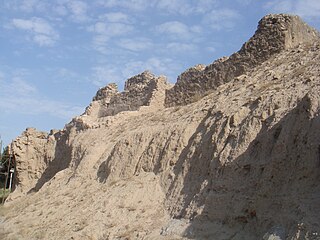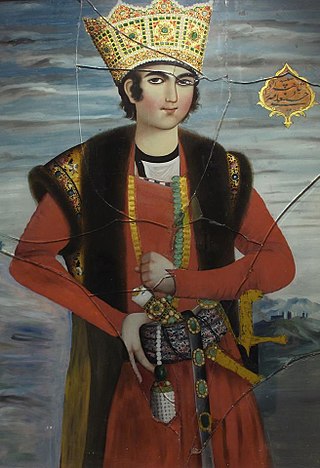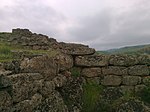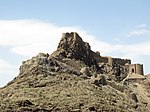
Shahr-e Ray or simply Ray is the capital of Ray County in Tehran Province, Iran. Formerly a distinct city, it has now been absorbed into the metropolitan area of Greater Tehran as the 20th district of municipal Tehran, the capital city of the country.

The Golestan Palace, also transliterated as the Gulistan Palace and sometimes translated as the Rose Garden Palace from Persian language, was built in the 16th century, renovated in the 18th century and finally rebuilt in 1865. It is the former official royal Qajar complex in Tehran.

Fath-Ali Shah Qajar was the second Shah (king) of Qajar Iran. He reigned from 17 June 1797 until his death on 24 October 1834. His reign saw the irrevocable ceding of Iran's northern territories in the Caucasus, comprising what is nowadays Georgia, Dagestan, Azerbaijan, and Armenia, to the Russian Empire following the Russo-Persian Wars of 1804–1813 and 1826–1828 and the resulting treaties of Gulistan and Turkmenchay. Historian Joseph M. Upton says that he "is famous among Iranians for three things: his exceptionally long beard, his wasp-like waist, and his progeny."

The Shāh Abdol-Azīm Shrine, also known as Shabdolazim, located in Rey, Iran, contains the tomb of ‘Abdul ‘Adhīm ibn ‘Abdillāh al-Hasanī. Shah Abdol Azim was a fifth generation descendant of Hasan ibn ‘Alī and a companion of Muhammad al-Taqī. He was entombed here after his death in the 9th century.

The Karabakh Khanate was a semi-independent Turkic Caucasian khanate on the territories of modern-day Armenia and Azerbaijan established in about 1748 under Iranian suzerainty in Karabakh and adjacent areas.

The al-Nabi Mosque is a famous mosque in Qazvīn. The mosque has an area of about 14,000 m2, and bears inscriptions indicating that Fath Ali Shah of the Qajar dynasty was the founder of the mosque. Other sources however indicate that the mosque has been in existence since the Safavid period. It is now believed that the architect of the structure was Ustad Mirza Shirazi with the date of construction being 1787. This glorious mosque also known as Masjed Nabi, Masjed Soltani or Masjed Shah.

Damghan is the capital of Damghan County, Semnan Province, Iran. At the 2006 census, its population was 57,331, in 15,849 families. It is situated 342 km (213 mi) east of Tehran on the high-road to Mashad, at an elevation of 1,250 m (4,101 ft). It is one of the oldest cities on the Iranian plateau, stretching back 7,000 years, and boasts many sites of historic interest. The oldest of these is Tappeh Hessar, lying to the southeast of the city, which holds the ruins of a castle dating from the Sasanian Empire.

Tang-e Vashi is a gorge and mountain pass in the Alborz range of Iran (Persia). It is a popular tourist attraction in Tehran Province.

The Shah Diamond was found at the Golconda mines in what is now Andhra Pradesh, South India, probably in 1450, and it is currently held in the Diamond Fund collection of Moscow's Kremlin Armoury.
Panah Ali Khan Javanshir was the founder and first ruler of the Karabakh Khanate under Persian suzerainty.

Cheshmeh-Ali is an ancient recreational place, located in the south of Tehran and north of Rey in the country of Iran. The spring is spot in the neighborhood of Ebn-e Babooyeh, Tughrul Tower, and below the Rashkan castle and next to Rey Castle and Fath Ali shah inscription. In the past, carpet sellers and people used to wash their carpets there, with their idea that the property of this spring water is good and clean for carpets and make them full lighter color by its mineral water.

Fath Ali shah inscription is located in Cheshmeh-Ali in Rey, Iran. This work is one of several inscriptions made in the Fath Ali Shah era, located on Cheshmeh-Ali hill. Fath Ali shah inscription is spot in north of Rey near Cheshmeh-Ali park and beneath the Rey Castle.

Rashkan Castle was a castle in Tehran Province in northern Iran. It was located near Cheshmeh Ali, Shah-Abdol-Azim shrine and Fath Ali shah inscription (Cheshmeh-Ali). The castle was intended to hold Rey, Iran. Rashkan castle was erected with plaster of lime and ashes or sand with stones. It was built during the Parthian rule of Persia.

Mohammad Taqi Mirza Hessam os-Saltaneh was a Persian Prince of the Qajar dynasty, son of Fath Ali Shah. He was Governor-General (beglerbegi) of Kermanshah and of Boroujerd.

The Jameh Mosque of Golpayegan is one of the important mosques of the Seljukid era and one of the large mosques in Iran. In view of its construction date, it may be said that its Iranian Islamic architecture was a model for building other large mosques specially the mosques, which were in the territory of seljukid dynasty. This mosque is located in the Masjed Jameh street in Golpayegan.

The Amir Chakhmaq Mosque, also known as Dahouk mosque, is a historical mosque from the Timurid era in Yazd, in Iran. It was built on orders of Jalal ed-Din Amir Chakhmaq Shami, who was the governor of Yazd and a general of Shahrukh Mirza. The mosque was completed in 1438. From the viewpoint of aesthetics, dimension and importance, it is one of the most outstanding buildings in Yazd.

Hossein Ali Mirza, a son of Fath-Ali Shah, was the Governor of Fars and pretender to the throne of Qajar Iran.

Ali Akbar Qavam ol-Molk was an Iranian statesman who served as the kalantar of Shiraz and Custodian of Astan Quds Razavi in the Qajar period. He was the youngest son of Hajji Ebrahim Shirazi, the grand vizier of Fath-Ali Shah who by the latter's order was executed, his family too, subsequently purged. Ali Akbar was one of the survivors. Later for appeasement by the orders of Fath-Ali Shah, his family lands were returned and he became the kalantar of Shiraz, thus marking the start of Qavam family.






































